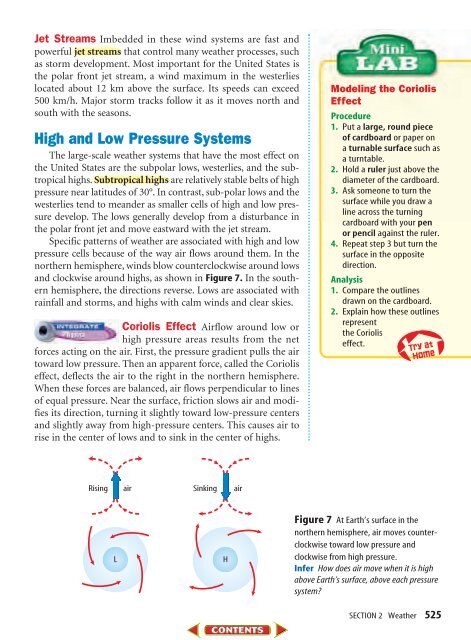CHAPTER 17 Weather and Climate - Mr. Barrow's Science Center
CHAPTER 17 Weather and Climate - Mr. Barrow's Science Center
CHAPTER 17 Weather and Climate - Mr. Barrow's Science Center
You also want an ePaper? Increase the reach of your titles
YUMPU automatically turns print PDFs into web optimized ePapers that Google loves.
Jet Streams Imbedded in these wind systems are fast <strong>and</strong>powerful jet streams that control many weather processes, suchas storm development. Most important for the United States isthe polar front jet stream, a wind maximum in the westerlieslocated about 12 km above the surface. Its speeds can exceed500 km/h. Major storm tracks follow it as it moves north <strong>and</strong>south with the seasons.High <strong>and</strong> Low Pressure SystemsThe large-scale weather systems that have the most effect onthe United States are the subpolar lows, westerlies, <strong>and</strong> the subtropicalhighs. Subtropical highs are relatively stable belts of highpressure near latitudes of 30°. In contrast, sub-polar lows <strong>and</strong> thewesterlies tend to me<strong>and</strong>er as smaller cells of high <strong>and</strong> low pressuredevelop. The lows generally develop from a disturbance inthe polar front jet <strong>and</strong> move eastward with the jet stream.Specific patterns of weather are associated with high <strong>and</strong> lowpressure cells because of the way air flows around them. In thenorthern hemisphere, winds blow counterclockwise around lows<strong>and</strong> clockwise around highs, as shown in Figure 7. In the southernhemisphere, the directions reverse. Lows are associated withrainfall <strong>and</strong> storms, <strong>and</strong> highs with calm winds <strong>and</strong> clear skies.Coriolis Effect Airflow around low orhigh pressure areas results from the netforces acting on the air. First, the pressure gradient pulls the airtoward low pressure. Then an apparent force, called the Corioliseffect, deflects the air to the right in the northern hemisphere.When these forces are balanced, air flows perpendicular to linesof equal pressure. Near the surface, friction slows air <strong>and</strong> modifiesits direction, turning it slightly toward low-pressure centers<strong>and</strong> slightly away from high-pressure centers. This causes air torise in the center of lows <strong>and</strong> to sink in the center of highs.Modeling the CoriolisEffectProcedure1. Put a large, round pieceof cardboard or paper ona turnable surface such asa turntable.2. Hold a ruler just above thediameter of the cardboard.3. Ask someone to turn thesurface while you draw aline across the turningcardboard with your penor pencil against the ruler.4. Repeat step 3 but turn thesurface in the oppositedirection.Analysis1. Compare the outlinesdrawn on the cardboard.2. Explain how these outlinesrepresentthe Corioliseffect.RisingairSinkingairLHFigure 7 At Earth’s surface in thenorthern hemisphere, air moves counterclockwisetoward low pressure <strong>and</strong>clockwise from high pressure.Infer How does air move when it is highabove Earth’s surface, above each pressuresystem?SECTION 2 <strong>Weather</strong> 525


